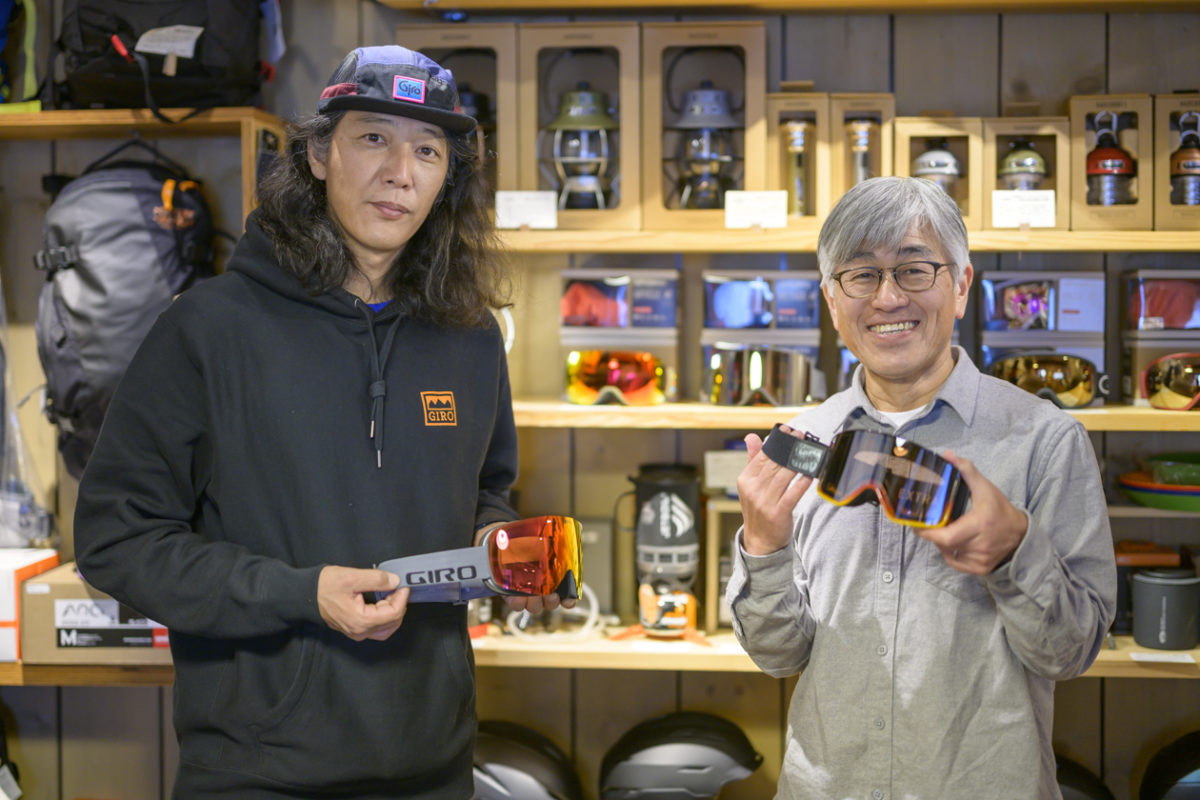Masahiro Yamaki, a professional skier who runs beginner-friendly BC tours in Japan while skiing in remote areas. And Takuro Hayashi, who runs the outdoor goods store Transit Higashikawa in Hokkaido while contributing to ski and snowboard magazines as a freelance writer. Why do these two slippers, who both love GIRO, continue to use this product? In order to clarify the reason, I threw the theme of "when to choose goggles".
Photo/ Yukinori Otsuka
If you look at goggles as a practical product
Hayashi: Mr. Yamaki, thank you very much for your time today.
Yamaki: Nice to meet you.
Hayashi: It's a quick question, but how long have you been with GIRO, Mr. Yamaki?
Yamaki: Well, it's been 15 years since GIRO started making snow goggles.
Hayashi: For that long, professional skiers have been using GIRO as their gear. Mr. Yamaki, what do you think are the key points when choosing goggles?
Yamaki: You suddenly got to the point (laughs). Well, one thing I think about is goggles, like skis and boots, are completely practical items. How useful it will be on the snow, isn't it?
Hayashi: Certainly.
Yamaki: So I think the most important thing is functionality.
Hayashi: You answered in the shortest way (laughs). I have no doubt about that. So, what I really think about is that goggles have two sides: functionality and marketability.
Yamaki: Oh, I totally understand that. Merchandise means appearance, price, and brand image, right?
Hayashi: Yes.
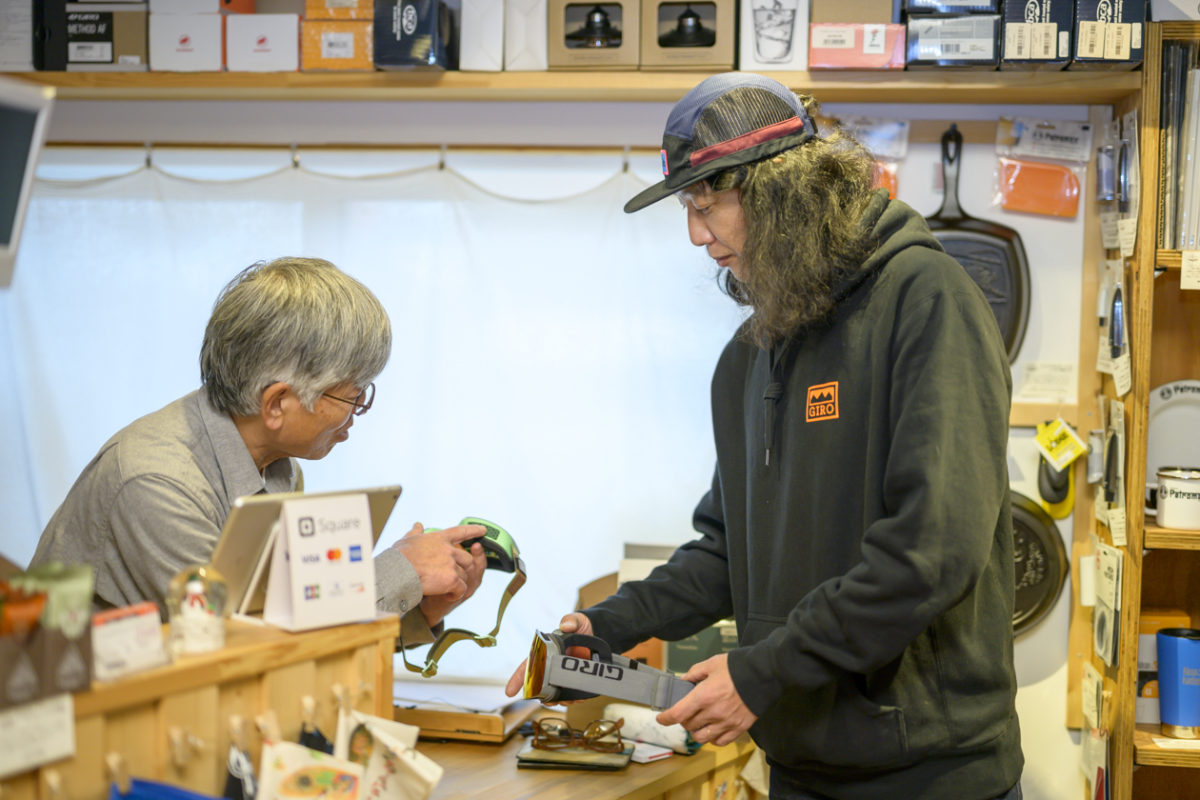
Yamaki: So, in terms of functionality, do you mean that things like visibility, lens characteristics, resistance to fogging, and fit are included?
Hayashi: That's right. Even though we have to talk about the two with completely different values, I feel like they are blending seamlessly. That's why users may not be able to organize what they want.
Yamaki: Yeah yeah.
Hayashi: I noticed this after I started running my own restaurant and started talking directly to customers.
Yamaki: I think that point of view is very easy to understand.
Hayashi: Mr. Yamaki, do you have the impression that GIRO focuses on functionality?
Yamaki: Exactly. Of course, there are products with very cool designs, such as the CONTOUR, AXIS, and METHOD Fender collaboration models that were released this season, and there are models with high cost performance, such as BLOK, so I think that the product quality is very important. However, the level of basic functions that are common to all such products is high. There is a place where the basic quality of making is one rank higher.
Hayashi: Do you have an image of creating a foundation with functionality and then adding marketability on top of that?
Yamaki: Right. Therefore, there is no mistake even if you choose it based on the product quality. However, if you know the functional part properly and choose it, you can reach a goggle that is really easy to use, and the goggles are so easy to see! I think it will take you to an unknown world.
GIRO specs directly linked to functionality
Hayashi: So, I would like to turn the discussion towards functionality.
Yamaki: Yes.
Hayashi: I would like to ask about the four pillars of functionality: visibility, lens characteristics, resistance to fogging, and fit.
Yamaki: Yes.
Hayashi: Mr. Yamaki, you've been using CONTOUR for a long time, haven't you? What is the reason for that?
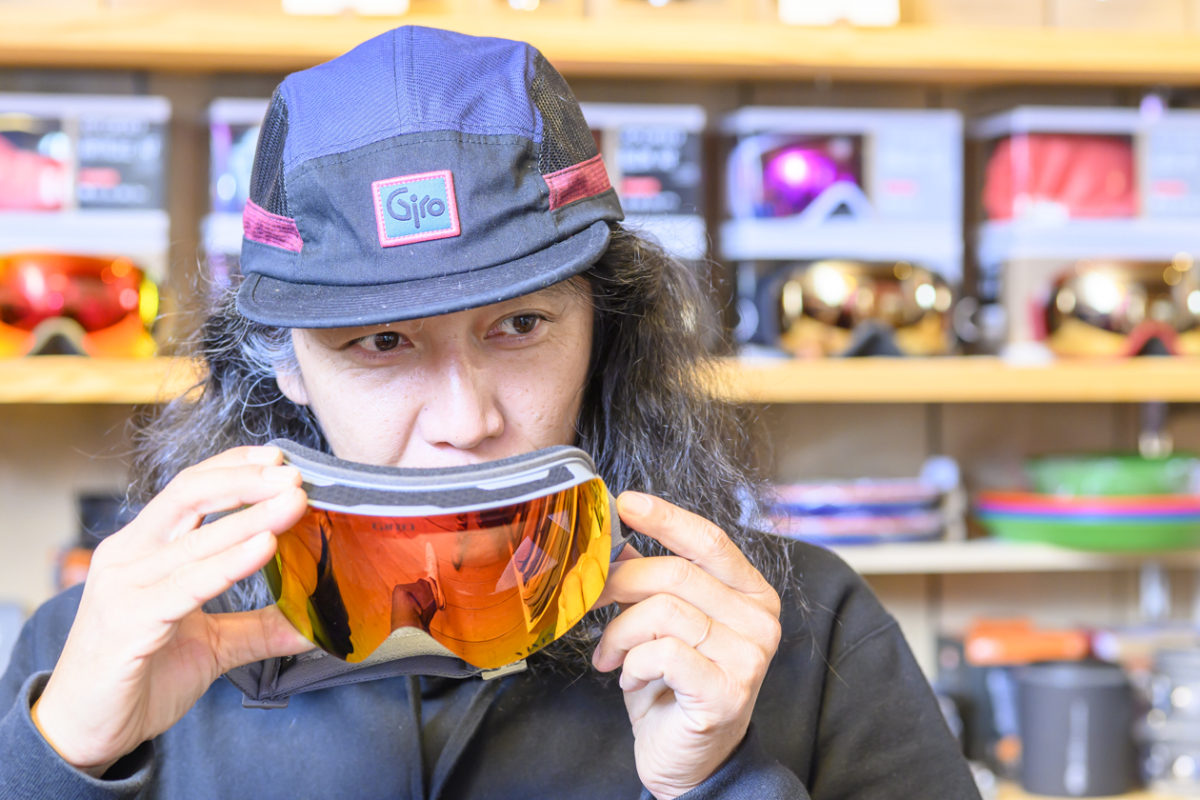
Yamaki: CONTOUR has a wide field of view. We use a frameless design technology called EXV+ technology, and the horizontal field of vision is the same as with the naked eye. After all, when I'm skating, I look at various places in detail. It would be great if you could move only your eyeballs at that time. If you move your neck because the frame is in your field of vision and it's hard to see, you won't be able to make it in time.
Hayashi: That's an opinion unique to a professional.
Yamaki: No, not everyone is aware of it, but it is. When you're skating, your eyes move more than you think. If you use CONTOUR, you'll probably think that the goggles you've been using so far have a narrow field of vision (laughs).
Hayashi: I see.
Yamaki: What about Mr. Hayashi? Where do you like the functionality?
Hayashi: I was really into the VIVID lens. It's not dazzling even when it's glaringly sunny. I don't feel any inconvenience even if I ski until the evening. Anyway, the range that can be covered with one lens is very wide.
Yamaki: That's right. Also, VIVID is easy to see in flat light conditions such as cloudy weather and blizzards.
Hayashi: That's right, the worse the conditions, the more good things come out. Because it emphasizes the contrast in weak light, the scenery becomes clear and easy to see even at night.
Yamaki: Actually, I like dark lenses. Even before the VIVID came out, when it was difficult to create contrast due to cloudy weather or a snowstorm, I used a slightly darker lens to lower the tone.
Hayashi: Is that so? It's the opposite of how it usually works.
VIVID lens technology effectively manipulates blue light by letting in contrast-enhancing blue light and blocking harmful UV light. By skillfully manipulating blue light, the VIVID lens removes haze in the field of view and accurately identifies the running line for clearer vision. It reduces eye fatigue, improves body responsiveness, increases confidence, and provides accurate vision without color saturation. For more information see this video
Yamaki: If you use a bright lens because you can't see with a flat light, your eyes might get used to the brightest part of your field of vision, and it's hard to see the dark part. So, when I tried the VIVID when it came out, I really liked how it looked with a slightly darker lens. The shadows in the darker areas were clearer than before.
Hayashi: This is a good one! Is it
Yamaki: That's right. This is what I wanted! What? Then I realized that I had chosen a dark lens, but it was not the darkness but the light transmittance. A lens that is only dark will not be able to see the shadows, but a lens with reduced transmittance will only suppress the light across the entire area from dark to bright, and there will be shadows even in the dark. world. It's very important for me to be able to achieve the way I like to look.
Hayashi: I see.
Yamaki: Hayashi-san, do you have such a thing?
Hayashi: I love VIVID's Onyx lenses for fine weather. It looks like a red lens. The moment I put them on, the scenery looks like a sunset, but after 10 minutes, I forget what color lenses I'm wearing. There is not that much color bias, and the color tone of the scenery is natural.
Yamaki: Yes, I know how you feel.
Hayashi: Depending on the brand, there are goggles that make you feel like you're looking through colored lenses all day long, but GIRO doesn't have that color bias. I also take pictures, so the fact that there is no color bias is very helpful.
Airflow for anti-fogging
Yamaki: Hayashi-san, you usually wear glasses, but do you wear contacts when you skate?
Hayashi: No. My eyes have double vision, so I see things twice. This cannot be corrected without glasses, so I wear glasses when I slip.
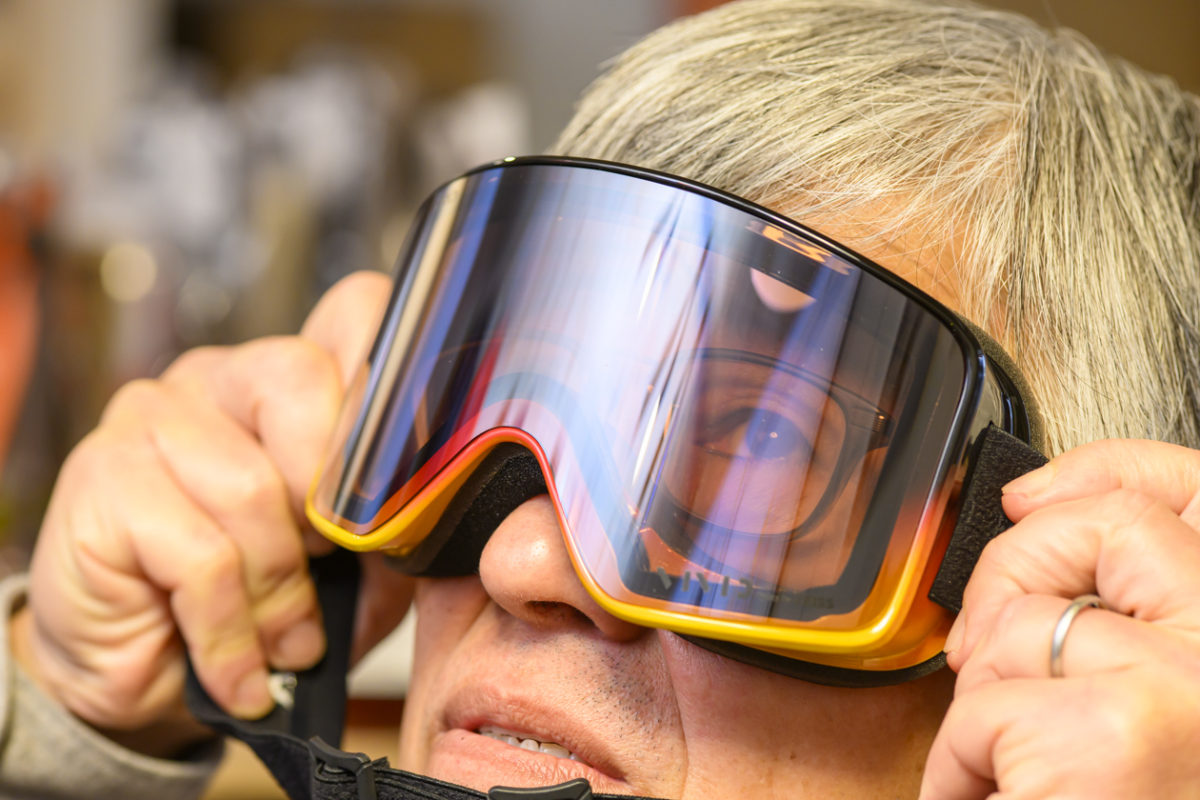
Yamaki: Then wouldn't the options for goggles be pretty narrow?
Hayashi: Actually, that's one of the reasons I chose GIRO. Almost all GIRO models are eyeglass compatible frames. Of course it depends on the size of the glasses, but I can use them without any problems.
Yamaki: That's right. But won't my glasses fog up?
Hayashi: Maybe it's because of the good airflow, but when I'm skating, it's almost non-existent. If you wear goggles while hiking, they may fog up, but I rarely have any problems with my glasses fogging up during normal use.
Yamaki: It's true that I've had trouble with my goggles fogging up...
Hayashi: In the case of Mr. Yamaki, there are times when the weather seems to change during filming, so you rush back up the mountain, right?
Yamaki: In such cases, I try to remove the goggles as much as possible, but even if I climb with them on, it may not get so cloudy. Well, the Contour I'm using has a magnetic lens, so you can just remove the lens.
Hayashi: Mr. Yamaki, the helmet is also a GIRO, so it may be less foggy.
Yamaki: That's right. Recently, goggle makers are making helmets, and helmet makers are starting to make goggles. Since the same place is made, there is no doubt that the shape is compatible. After that, the wind taken into the helmet is skillfully passed through the goggles to prevent fogging, and the thickness of the helmet and the height of the base of the goggle strap are properly matched.
Hayashi: It seems like you're making the most of your small ingenuity.
Yamaki: In that sense, it's better to have goggles and helmets from the same manufacturer. Additionally, a helmet is a must. terrible! Collide! I can't go to buy a helmet after thinking about it.
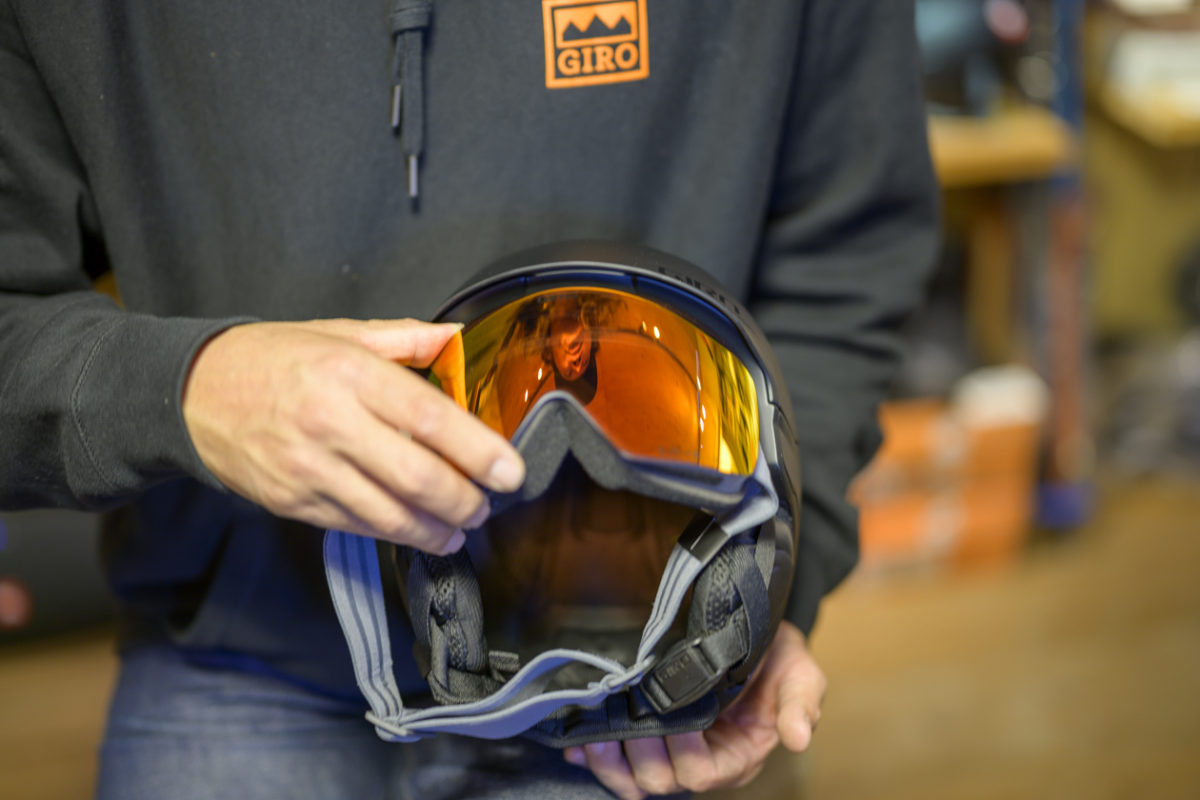
Hayashi: It's best to have people laugh at me, saying, "I wore this, but it was useless, and it was a waste of an expensive purchase."
Yamaki: I really think so.
I want to check compatibility, not good or bad
Yamaki: I'm a GIRO athlete, so I only use GIRO.
Hayashi: Yes.
Yamaki: Even so, you still use GIRO now, and you also have GIRO in your store.
Hayashi: Yes.
Yamaki: Is there a reason for that?
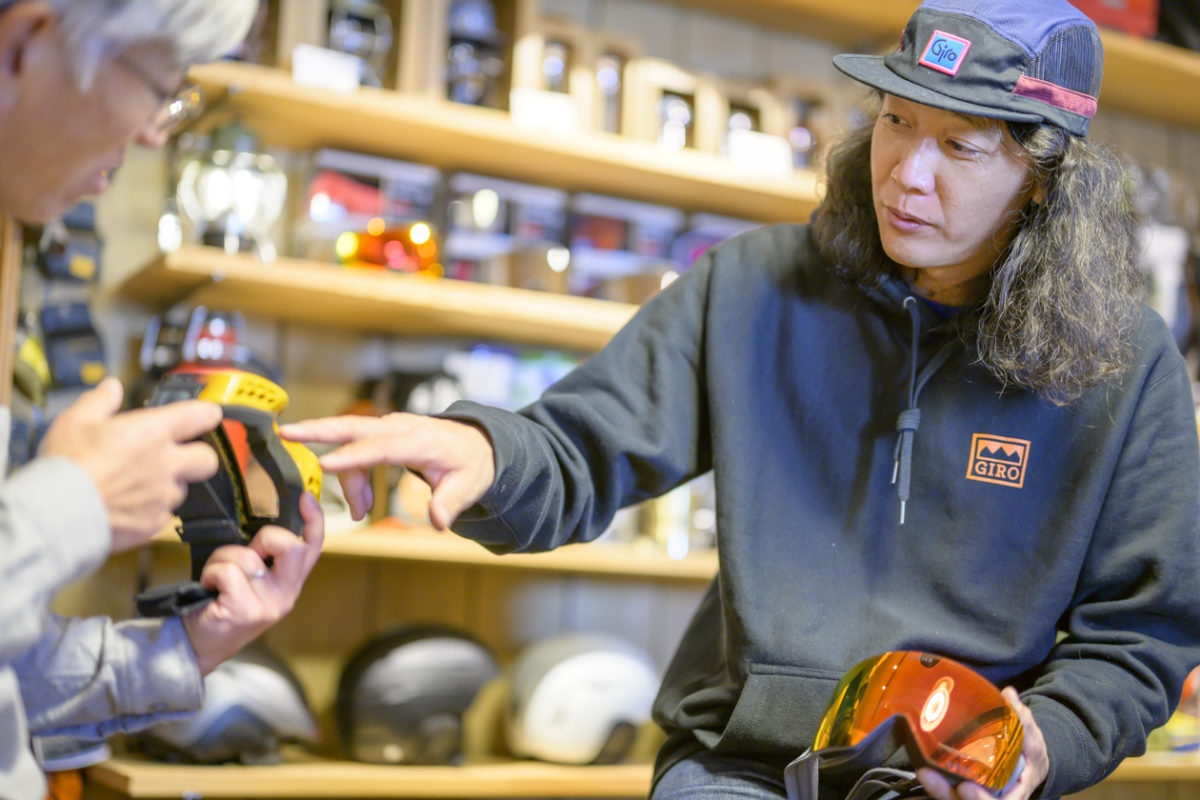
Hayashi: Well, in a nutshell, as I said earlier, the VIVID lens fits.
Yamaki: There are times when you need to explain this to your customers, right? how are you talking
Hayashi: Well, as you know, the human eye perceives three colors of light: red, green, and blue.
Roughly speaking, the recent high-contrast goggle lenses are designed to match the wavelengths of colors that humans perceive, to emphasize red, to emphasize red and green, and to emphasize blue. It can be divided into types. Of these, the VIVID lens, jointly developed by GIRO and the prestigious German optical manufacturer ZEISS, emphasizes blue.
The reason why snow looks white is because it reflects various colors of light in the same way that transparent ice becomes white when shaved ice is used. The true color of snow is blue. That's why GIRO emphasizes the light and shade based on the original color of the snow, so that even in low light conditions such as cloudy weather and snowstorms, the shadows are clearly defined and things can be seen clearly.
Yamaki: Oh, it's easy to understand.
Hayashi: First of all, I want people to know that there are differences in characteristics: one that emphasizes red, one that emphasizes red and green, and one that emphasizes blue.
It's not about which one is better or worse, nor which one is better. The characteristics of the human eye differ depending on the individual and race, and people also have preferences in how they see things. It would be great if you could choose goggle lenses that match the characteristics of your eyes.
Yamaki: Yes, that's certainly true.
Hayashi: Well, the problem is that you can't tell what it will look like in the snow, even if you put goggles on your face at the store.
Yamaki: That's right.
Hayashi: Lately, I've been seeing places in stores asking people not to touch their goggles. There are a lot of online shopping, and I think there are fewer opportunities to actually pick up the products. When that happens, even when choosing goggles, you end up relying on brand image, design, price, and product information such as reputation.
Yamaki: Yeah yeah.
Hayashi: But I think the most important thing is functionality. When that happens, actually try using it on the snow, and let the user decide for themselves that this is the way they want to see, that this goggle does not fog easily, and that this foam does not cause discomfort even when used for a long time. I think you have no choice but to judge. That's why "Transit" rents GIRO goggles.
Yamaki: Oh, that's good.
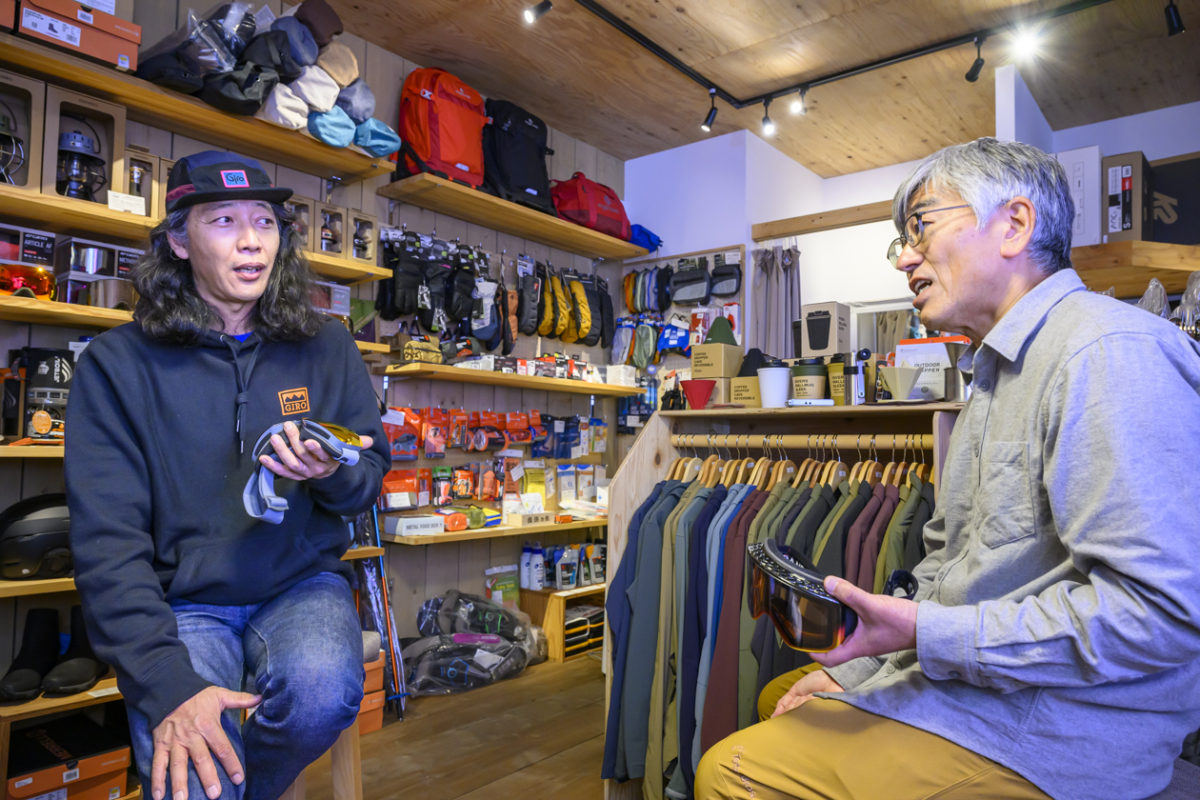
Hayashi: It's just a small number of models that we have in stores. Even so, if you compare the VIVID lenses with your own goggles in your usual field, you will be able to see if GIRO is right for you, and I think you will be satisfied with the functionality. increase.
Yamaki: It's a service that can only be provided by a shop close to the mountains.
Hayashi: As Mr. Yamaki said, I think goggles are practical items. In that case, I think the feeling of the buyer is that they want to actually try it. Have them use it on the snow to see how well the GIRO goggles fit them. How well does the VIVID lens, which emphasizes blue, suit me? Even if you just know that, I think you'll get closer to the correct answer for choosing goggles.
Small considerations for long-term use
Yamaki: Also, there are things that really bother me.
Hayashi: Yes.
Yamaki: After skating, I see people drying their goggles by putting them on the dashboard of their car and blowing the defroster wind on them.
Hayashi: Yes, I see it often.
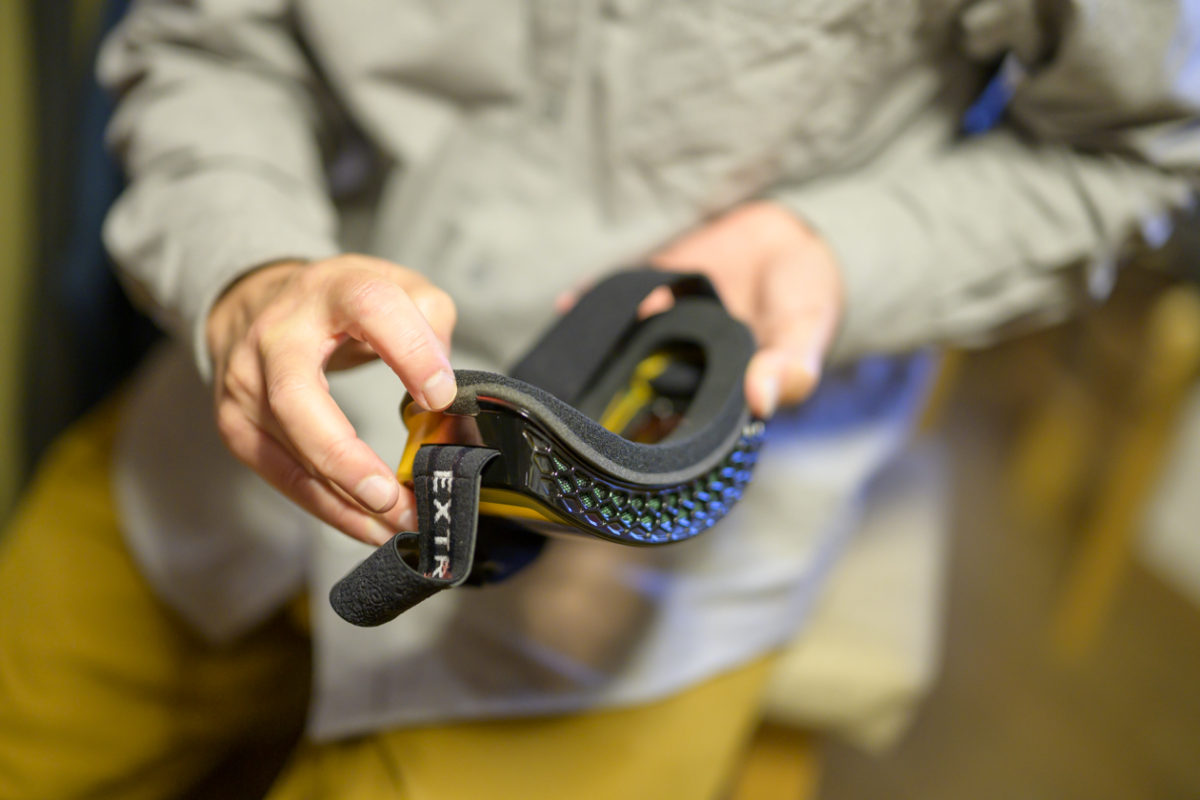
Yamaki: It's not limited to GIRO, but I think we should stop doing that. The defroster uses hot air, and depending on the situation, the foam adhesive may deteriorate.
Hayashi: I see. I mean, there's no need to dry it so quickly in the first place, is it? Isn't it?
Yamaki: That's right. Since it should be dry before the next slip, it should be slower. It should be less likely to deteriorate if you dry it at a temperature close to the actual usage. In that sense, I think it would be better in a cooler place, like in the back seat of a car.
Hayashi: How about leaving the snow on after you've finished skiing?
Yamaki: That wouldn't be good. It's troublesome if moisture gets in between the double lenses. It is recommended to remove the snow that can be removed and dry slowly at a low room temperature.
Hayashi: It means to treat them kindly.
Yamaki: That's right. It's just a little thing. Whether it's wiping wet lenses, drying used goggles, or storing them during the summer, I take care not to stress the products. It just lasts a long time.
Hayashi: It's definitely not a cheap purchase.
Yamaki: That's true. I sometimes use goggles in extremely difficult situations, so much so that I carry several spares and change them one after another. I know this because I've done so many things. If you take good care of them, your goggles will last a long time.
Hayashi: Like that, it feels good to keep using something with high functionality for a long time.
Yamaki: Above all, skiing itself becomes a notch more fun when it's highly functional. That's why I want you to think about choosing something that really suits you based on functionality.
Hayashi: Thank you very much.
Yamaki: Let's ski a lot this winter too!
GIRO's popular model CONTOUR that Masahiro Yamaki

A frameless model that boasts almost the same field of view as the naked eye. GIRO's unique EXV+ technology achieves a natural look that doesn't make you feel the presence of a frame. The lens is equipped with a VIVID lens unique to GIRO. By highlighting the original color of the snow, it emphasizes the contrast of shadows and ensures clear visibility even on cloudy or snowstorm days. In addition, the quick-change lens exchange system that uses magnets makes it easy to change lenses, and is tough enough to prevent the lens from coming off even if the camera falls over. A spare lens for cloudy weather is included.
the person who taught me
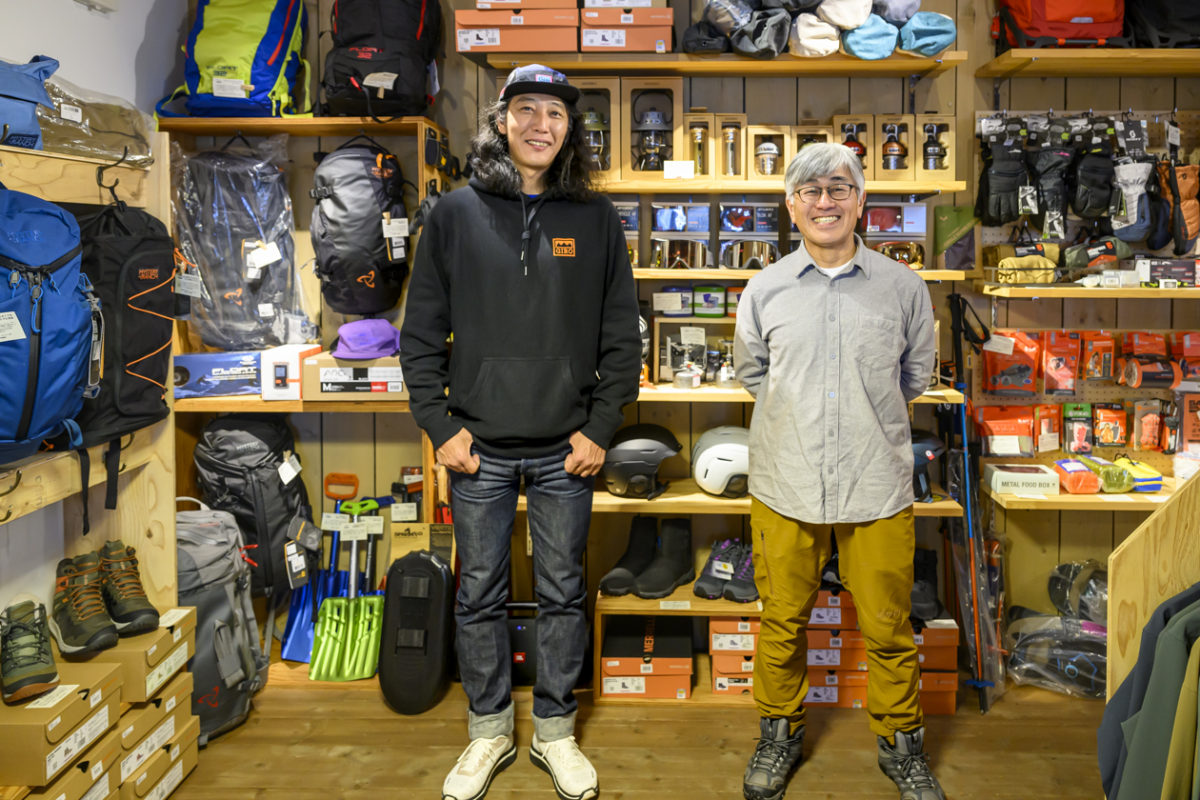
Masahiro Yamaki
Lives in Sapporo, Hokkaido. Downhill the world's big mountains such as Denali (6,190m) in North America in 2000, Pisco Peak (5,475m) in the South American Andes in 2006, and Pequeno Alpamayo (5,370m) in the South American Andes in 2010. On the other hand, in Japan, he is working hard to enhance the ski culture by holding technique camps and deep snow courses for beginners. While he is interested in various DIYs, he is also known as a lover of old cars.
Takuro Hayashi
For many years, he has worked as an editor, writer, and photographer, mainly for snowboarding, skiing, and outdoor magazines. He loved skating so much that he moved to Hokkaido in 2014 and opened a travel and outdoor gear store called “Transit Higashikawa” in Higashikawa town at the foot of Mt. Asahidake. Many products are lined up based on the deep knowledge and experience he has cultivated so far. The stance is clear at a glance when you look at the detailed description of each post on Instagram. It's open from the morning, so it's nice to be able to stop by before going to the field.

